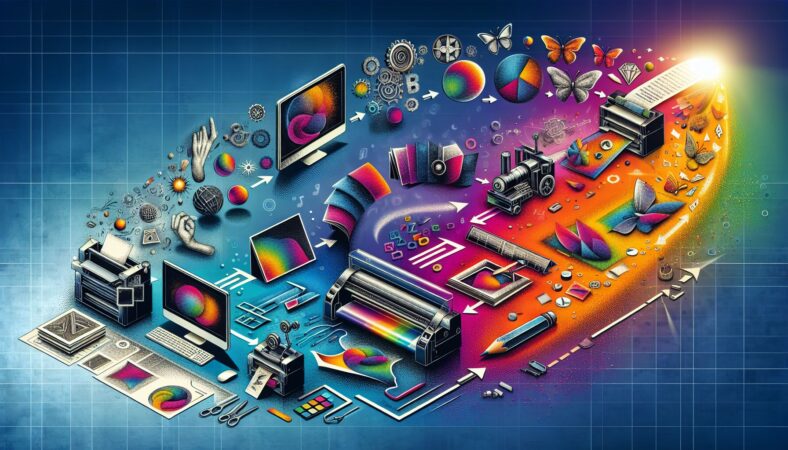Are you tired of seeing your digital designs confined to the screen? Do you dream of transforming your creations into tangible, physical masterpieces? Printing design is the process that can bridge the gap between the digital realm and the physical world, allowing your creativity to shine on paper. Whether you’re a graphic designer, a photographer, or an artist, understanding the intricacies of printing design can elevate your work to a whole new level. In this article, we’ll delve into the world of printing design, exploring its importance, techniques, and best practices.
The Importance of Print Design
In an increasingly digital age, one might wonder why print design still holds such significance. The truth is, print design offers a unique sensory experience that digital mediums simply cannot replicate. Tactile sensations, such as the texture of paper or the weight of a book, can evoke emotions and create a lasting impression. Additionally, print design allows for more careful curation and control of colors, ensuring the fidelity of your artwork. Hence, understanding print design is crucial for anyone looking to make an impact through their creative endeavors.
Preparing Your Designs for Print
Before we dive into the intricacies of printing techniques, it’s essential to discuss the preparatory steps required to ensure your designs are print-ready. Here’s a step-by-step guide to transforming your digital designs into tangible prints:
1. Choosing the Right File Format and Resolution
Start by ensuring your designs are saved in the appropriate file format. Typically, it’s best to use a lossless file format such as TIFF or PNG to prevent any loss in quality during the printing process. Additionally, pay attention to the resolution of your images. Aim for 300 pixels per inch (PPI) to ensure crisp and clear prints.
2. Color Space Management
Maintaining color consistency is crucial when transferring your designs from the screen to paper. Calibrate your monitor and work in a color space compatible with the printing process, such as CMYK (Cyan, Magenta, Yellow, Key/Black). This ensures that the colors you perceive on the screen accurately reflect the final printed result.
3. Bleed and Safe Area
To accommodate any slight variations in the printing process, it’s essential to include bleed and safe areas in your designs. Bleed refers to extending the design beyond the final trim size, allowing for any inconsistencies in trimming. Safe areas, on the other hand, ensure that no critical elements are too close to the edges, preventing accidental cropping.
4. Typography and Fonts
Selecting the right typefaces and ensuring legibility is crucial in print design. Pay attention to font sizes, line spacing, and avoid serif fonts at small sizes, as they may appear blurry and illegible. Embed the fonts in your design files or provide them separately to ensure accurate reproduction.
5. Collaboration and Proofing
Whenever possible, collaborate with your printer or a professional print designer. They can provide valuable insights and ensure your design is optimized for the printing process. Proof your designs thoroughly, checking for any errors or inconsistencies in colors, layout, or typography.
Printing Techniques and Considerations
Now that you have prepared your designs for print, let’s explore some of the essential printing techniques and considerations to ensure your designs come to life as intended:
1. Digital Printing
Digital printing is a versatile and cost-effective option, suitable for small to medium print runs. It offers quick turnaround times and excellent color reproduction. With digital printing, you can experiment with various paper finishes, weights, and sizes, allowing you to tailor your prints for specific purposes, such as flyers, postcards, or brochures.
2. Offset Printing
Offset printing, also known as lithography, is ideal for high-volume printing projects. It produces sharp and high-quality prints, making it a popular choice for books, magazines, and large-scale marketing materials. Offset printing provides a wide range of paper options and finishes, giving you complete control over the appearance of your prints.
3. Specialty Printing Techniques
For those seeking a unique and visually striking result, consider exploring specialty printing techniques. Techniques such as embossing, foil stamping, and spot UV can add texture, shine, and dimension to your designs. However, it’s essential to collaborate closely with your printer to ensure these techniques are correctly executed, as they require additional consideration during the design and printing stages.
4. Paper Selection
Choosing the right paper is paramount to the success of your print design. Consider the weight, texture, color, and finishes available. Matte finishes offer a subtle elegance, while glossy finishes deliver vibrant colors and enhanced contrast. Textured papers can add depth and character to your prints, offering a tactile experience.
5. Environmental Considerations
As creators, we also have a responsibility to consider the environmental impact of our printing choices. Opt for printers that use sustainable practices, such as recycled paper, vegetable-based inks, and environmentally friendly printing methods. Making mindful choices not only benefits the planet but also aligns your creativity with sustainable values.
Conclusion
Embarking on the journey of print design allows you to move beyond the digital realm, transforming your creations into extraordinary physical manifestations. From the preparatory steps to the printing techniques and considerations, each aspect plays a crucial role in delivering your vision onto paper. By understanding the nuances of print design and collaborating with experienced print professionals, you can unleash the full potential of your creativity and leave a lasting impression with your art. So, why limit yourself to the pixels on the screen when a world of printing design awaits? Embrace the art of print, and let your imagination flourish on paper.
